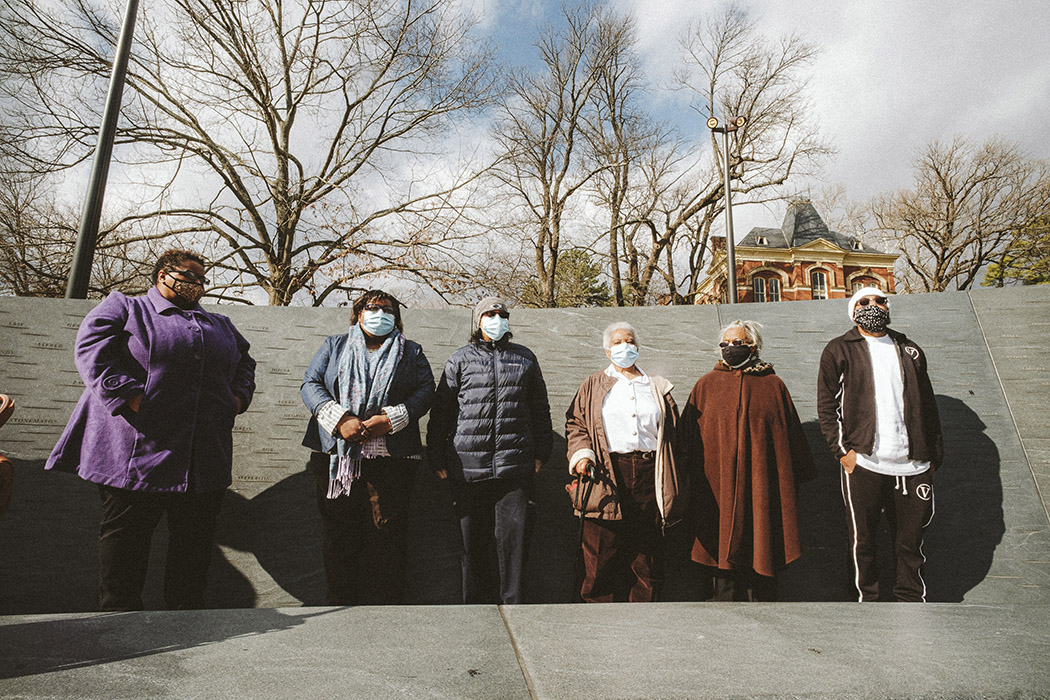At UVA’s Memorial to Enslaved Laborers, some people are remembered by name: Billy, Jane, Lewis. Others are remembered by occupation or relationship: Woodcutter, grandmother. And others still are represented by nothing more than gashes in the hard rock, denoting a life’s worth of details lost to history.
Standing in front of the wall, Myra Anderson’s eyes fell upon the name of her ancestor, Thirmston Hern, who had been enslaved at Monticello and sold to a university professor following the death of Thomas Jefferson.
Thirmston was not alone, Anderson learned. Five other members of his family were also sold and enslaved at the university—yet their names were not initially included on the University of Virginia’s memorial, which opened last year.
Earlier this month, however, Anderson’s five ancestors were finally etched into the granite wall: Davy Hern, Fanny Gillette Hern, Bonnycastle Hern, Lily Hern, and Ben Snowden.
The additions were unveiled to Anderson and her family during a small ceremony last week.
“It was a really heavy and emotional moment,” says Anderson, who grew up in Charlottesville. “It was more than just getting those names on the wall. It was really bringing dignity to my ancestors—slavery is something that robbed them of that.”
Since her ancestors were first enslaved at Monticello, Anderson was able to dig up estate sale records, along with books and documents, proving that the Herns had also lived and worked at the university. In addition, she discovered that Thirmston, Davy, and Lily were siblings.
For over a year, she contacted various university faculty and staff, advocating for the Herns to be honored on the memorial wall. But because there was no established process for adding names to the monument, it took a while to connect with the right person.
“I don’t think it was an issue of reluctance or resistance, as much as it was process,” she says. “At times I did want to give up, but I thought about my ancestors and it’s not in my DNA to do that.”
In December, Anderson finally received an apology letter from the university, announcing that her ancestors would be added to the memorial the following month.
Anderson’s persistence ultimately led the university to establish an official MEL Names Committee, composed of historians, genealogists, alumni, architects, and descendants.

From 1812 to 1865, an estimated 4,000 people were enslaved at UVA, and each is represented by a deep gash carved into the memorial wall. But researchers have only been able to find the names of 588 enslaved people, along with 311 people known by their occupation or kinship relation, to put above the memory marks.
“The MEL Names Committee is dedicated to working with genealogists and seeing the 4,000 memory markers on the memorial filled with the names of enslaved laborers,” says Carolyn Dillard, head of the committee. “[But] this is not just about a memorial wall—this is talking about people’s hearts and families that have been divided. We want to make sure we are engaging with descendants respectfully.”
At times I did want to give up, but I thought about my ancestors and it’s not in my DNA to do that.”
Myra Anderson, Descendant
Though the university will continue to look for people to add to the memorial, descendant families are strongly encouraged to bring forward names to be validated by genealogists, says Dillard.
Every year, new names will be added to the wall, and unveiled at a ceremony for descendant families.
Anderson hopes that the new committee will make the approval process much easier for other descendant families, even those with very few historical records.
“My worry is for the descendants who will come along whose ancestors didn’t come from Monticello or some place that had all of these documentations. Because during slavery, records are hard to find,” she says.
“We want descendants to come forward to share any documentation that they have—even oral history,” says Dillard.
Anderson also calls on UVA to continue to address and rectify its racist past, such as by creating legacy scholarships for descendants of people enslaved at the university.
“This university has flourished off of the labor, blood, sweat, and tears of my ancestors and other enslaved laborers,” she says. “When you’re thinking of righting wrongs of the past, that seems like a no-brainer.”
